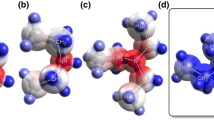Abstract
The montmorillonite-catalyzed reactions of D, L-ImpA with D, L-ImpU generates RNA-like oligomers. The structures of the dimers to pentamers were investigated and homochiral products were identified in greater amounts than would be expected if theoretical amounts of each were formed. The homochirality increased from 64% to 97% as the chain length increased from dimers to pentamers. Investigation of the effect of pH, occupancy of the interlayer space and the influence of various cations in the reaction provided further insight into physical process in the mechanism of the catalysis. A detailed analysis of dimers was carried out in view of there being key intermediates towards formation of higher oligomers. The study was extended to the synthesis of non-standard dimers including those formed with deoxy-ribonucleotides.
Similar content being viewed by others
Introduction
RNA is proposed to be an important biopolymer in the early life on Earth where it would have provided both catalysis and the ability to store genetic information (Cech et al. 1981; Gilbert 1986; Guerrier-Takada et al. 1983). Most hypotheses of the origins of biological organization have suggested that RNAs with length in the range of 30–50 nucleotides are needed to initiate catalysis that makes a genetic system viable (Szostak and Ellington 1993; Joyce and Orgel 2006). Studies from our laboratory have demonstrated the montmorillonite-catalyzed formation of RNA-like oligomers from activated mononucleotides (Ferris 2002). Our current studies are focused on the investigation of reactions of racemic monomers to understand how chiral selectivity was introduced in the prebiotic system. Since the first step of RNA synthesis proceeds via formation of dimeric species, their synthesis was investigated in greater detail. In addition, to provide a clear picture of the mechanism taking place in the montmorillonite catalysis, several new issues are addressed in order to reach a more detailed understanding of the oligomerization process.
Results and Discussion
Formation of Oligomers
Reaction 1
A Na+-montmorillonite-catalyzed reaction of a D-ImpA with D-ImpU (total activated mononucleotide: 15 mM), which was reacted for 3 days produced oligomers as long as 9 mers as determined by HPLC analysis on an ion exchange column.
Reaction 2
A Na+-montmorillonite-catalyzed reaction of the equimolar quaternary mixture of D, L-ImpA with D, L-ImpU (total activated mononucleotide: 15 mM) in which the chain length of oligomers increased to 11-mer over 3 days.
The products from dimer to pentamer were separated by anion exchange HPLC analysis. The terminal 5′-phosphate groups were cleaved by alkaline phosphatase for further analysis on an Alltima reverse phase column.
Formation of Dimers
The dimers of Reaction 2 were separated into 12 linear and 3 cyclic products. For their identification, a synthetic method has been developed to specifically provide dimers comprising standard nucleotide residues. A ribonucleoside 5′-phosphorimidazolide, ImpN, is added to a nucleoside in the presence of a Na+-montmorillonite catalyst at neutral pH with the absence of protecting groups. In general,
In all cases, no protecting groups are used and the only activating group is imidazole. The method is also robust with concentrations as low as 2–4 mM still providing high yields of products. The concentration of the nucleoside N1 is generally made twice that of ImpN2. Approximately 30% of the imidazolide is converted into the 2′–5′ product, 30% into the 3′–5′ product with the rest hydrolyzed to the corresponding 5′-monophosphate. The method has been extended to include non-standard ribonucleosides and the synthesis of trimers. Experiments with deoxynucleosides, the 5′-phosphorimidazolide of deoxyadenosine and other non-standard components and combinations have suggested the limits to which this method may be successfully applied. The homochiral and heterochiral syntheses from enantiomeric nucleosides have also been successfully carried out with methods developed for the optimized syntheses of dimers from D- and L-adenosine and D- and L-uridine (Joshi et al. 2011). The unusual nature of the fragments observed in mass spectrometry of products from ImpG alone and the very low dimer yields with ImpG were most probably due to the formation of tetraplex species of ImpG that do not insert themselves into the montmorillonite platelets. Studies of the syntheses of dimers from ImpN with nucleosides or nucleotide 5′-monophosphates have provided evidence about their relative efficiencies.
Progress Towards Demonstrating Homochirality in Model Studies of Prebiotic RNA Synthesis
We have shown earlier that the production of oligomers by the individual reactions of D, L-ImpA or D, L-ImpU on montmorillonite catalyst produced oligomers that were only partially inhibited by the incorporation of both D- and L-enantiomers (Joshi et al. 2007). Homochirality selectivity in these reactions was largely due to the formation of cyclic dimers that do not elongate. In this study, quaternary reactions of D, L-ImpA and D, L-ImpU on Na+-montmorillonite for 3-days showed formation of oligomers up to 11-mer. The dimer, trimer, tetramer and pentamer fractions (yields 43.3% to 14.5%, 5.8% and 3.0%, respectively) were investigated for homochiral selection. These fractions were analyzed by reverse phase HPLC for the identification of homochiral and heterochiral isomers. For the determination of the extent of homochirality of dimers, oligomerization reactions of 1.2 mM and 0.6 mM D, L-ImpA with D, L-ImpU on Na+-montmorillonite were carried to minimize the formation of trimer and higher oligomers. The extent of homochirality of the dimer was 64%. The trimer homochiral percentage was determined from the reactions of 15 mM, 4.8 mM and 2.4 mM quaternary reactants. Out of the 16 trimers isolated, 10 were homochiral with an overall homochirality of 76% (Joshi et al. 2011). The tetramer and pentamer of the quaternary reaction were separated into 26 and 22 isomers, respectively, on a reverse phase HPLC column. Detailed comparisons revealed that the binary tetramers and pentamers co-eluted predominantly with those formed in the quaternary reactions. This corresponded to a minimum of 93% and 97% homochirality, respectively, at the HPLC detection level. These results suggest that Na+-montmorillonite not only catalyzes the prebiotic synthesis of RNA-like products, but also facilitates homochiral selection.
The Role of Na+-montmorillonite in its Catalysis of Activated Nucleotide Oligomerization
To provide a clearer picture of the mechanism in the montmorillonite catalyzed synthesis of RNA-like oligomers; we felt that several issues needed addressing as we endeavored to determine more detailed features of the oligomerization process. The effect of pH may influence the oligomer product distributions and pH may also affect the shape and size of the activated nucleotides. The negatively charged montmorillonite layer can efficiently catalyze the reaction of anionic activated nucleotides so we explored the variation of adsorption with pH and then related the finding to the product distributions. The occupancy of the interlayer by activated monomers as the reactions occur and the resultant change in the layer spacing was determined by X-ray diffraction. By applying the Scherrer equation (Scherrer 1918) to diffraction peak widths, evidence is provided that the nucleotides were indeed occupying the interlayers of the montmorillonite. The charge on the surface of a non-catalytic montmorillonite and/or the numbers of cations in the interlayer space could prevent access to the layers for the activated nucleotides. We showed that the catalytic process is dependant upon the cations present.
These outcomes provided details of the physical processes occurring as the oligomerization occurs on the montmorillonite surface. In turn, this will be significant to our continuing studies on the origin of life in which we have already addressed key points (Joshi et al. 2009) using activated nucleotides such as ImpA.
Conclusions
Catalytic montmorillonite platelets serve as selective templates for the formation of RNA-like oligomers. It is expected that if nucleosides were formed on the primitive Earth they would be present as racemic mixtures. It was surprising to discover that the extent of homochirality of the dimers and trimers formed from the quaternary reaction of D, L-ImpA and D, L-ImpU was greater than was observed from the reaction of D, L-ImpA or D, L-ImpU alone. It is postulated that the montmorillonite catalyst binds the quaternary mixture of activated nucleotides on its surface so that homochiral products are favored because of dipole interactions. The most significant finding of quaternary reactions is that no cyclic dimers of U were detected and the cyclic dimers of A were reduced from 60% to 10% in the dimer fractions. It is clear that addition of D, L-ImpA to the D, L-ImpU caused changes in binding and specific orientation. As a result less cyclic dimers are formed. Another significant observation is that the extent of homochirality of products increased from 64% to 97% as the chain length increased from dimer to pentamer. Several other features such as the magnitude of surface charge on the montmorillonite lattice, pH and interlayer spacing provided a basis for understanding of the physical processes in the mechanism of catalysis. In view of the greater degree of homochirality and sequence selectivity, the quaternary reactions on montmorillonite demonstrate a favorable route towards understanding the prebiotic synthesis of RNA.
References
Cech TR, Zung AJ, Grabowski PJ (1981) In vitro splicing of the ribosomal RNA precursor of Tetrahymena: involvement of a guanosine nucleotide in the excision of the intervening sequence. Cell 27:487–496
Ferris JP (2002) Montmorillonite catalysis of 30–50 mer oligonucleotides: laboratory demonstration of potential steps in the origin of the RNA world. Orig Life Evol Biosph 32:311–332
Gilbert W (1986) The RNA world. Nature 319:618
Guerrier-Takada C, Gardiner K, Marsh T, Pace N, Altman S (1983) The RNA moiety of ribonuclease P is the catalytic subunit of the enzyme. Cell 35:849–857
Joshi PC, Pitsch S, Ferris JP (2007) Selectivity of montmorillonite catalyzed prebiotic reactions of D, L-nucleotides. Orig Life Evol Biosph 37:3–26
Joshi PC, Aldersley MF, Delano JW, Ferris JP (2009) Mechanism of montmorillonite catalysis in the formation of RNA oligomers. J Am Chem Soc 131:13369–13374
Joshi PC, Aldersley MF, Ferris JP (2011) Homochiral selectivity in RNA synthesis: montmorillonite-catalyzed quaternary reactions of D, L-purine and D, L-pyrimidine nucleotides. Orig Life Evol Biosph 41:213–236
Joyce GF, Orgel LE (2006) Progress toward understanding the origin of the RNA world. In: Gesteland RF, Cech TR, Atkins JF (eds) The RNA world, 3rd edn. Cold Spring Harbor Laboratory Press, Cold Spring Harbor, pp 23–56
Scherrer P (1918) Estimation of the size and internal structure of colloidal particles by means of Röntgen rays. Nachr. Ges. Wiss. Gottingen, 96–100
Szostak JW, Ellington AD (1993) In vitro selection of functional RNA sequences. In: Gesteland RF, Atkins JF (eds) The RNA world. Cold Spring Harbor Laboratory Press, Cold Spring Harbor, pp 511–533
Acknowledgements
This research was supported by NASA Astrobiology Institute grant NNA09DA80A.
Author information
Authors and Affiliations
Corresponding author
Rights and permissions
About this article
Cite this article
Joshi, P.C., Aldersley, M.F., Price, J.D. et al. Progress in Studies on the RNA World. Orig Life Evol Biosph 41, 575–579 (2011). https://doi.org/10.1007/s11084-011-9255-0
Received:
Accepted:
Published:
Issue Date:
DOI: https://doi.org/10.1007/s11084-011-9255-0




